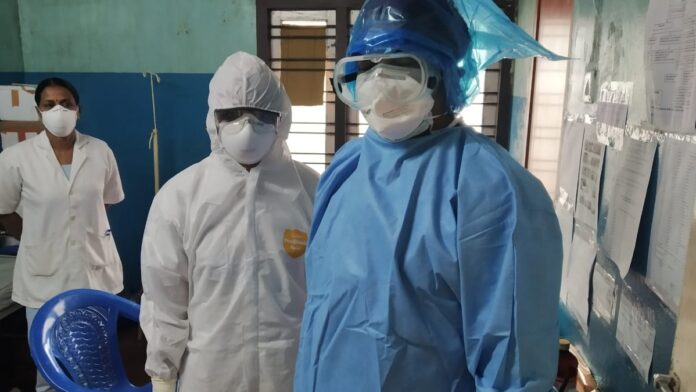
Louisville health care workers experienced an increase in SARS-CoV-2 infection from May to July, according to the Co-Immunity Project, the University of Louisville’s groundbreaking initiative to track COVID-19 in Metro Louisville. In July, the Co-Immunity Project tested health care workers as part of the second round of Phase I of the project, which tracks current and previous exposure to SARS-CoV-2, the virus that causes COVID-19, among health care workers. Despite the increase, their rates remained significantly lower than those of the general public, which project leaders believe may be the result of personal protective equipment (PPE) use and other safety procedures.
For testing, 1,100 health care workers collected their own blood and nasal swab samples and delivered them to researchers at UofL’s Christina Lee Brown Envirome Institute. The samples were tested for both the presence of the coronavirus and antibodies against the virus, which indicate previous exposure. The samples were analyzed by the Center for Predictive Medicine for Biodefense and Emerging Infectious Disease (CPM) in UofL’s Regional Biocontainment Laboratory (RBL), one of only 12 such NIH-funded laboratories in the nation and the only one in Kentucky.
In the new survey, the overall positivity rate for active infection was 0.45%, which is three times higher than the rate of 0.14% seen in 1,372 health care workers tested for the project in April and May.
“Although the overall number of positive cases among health care workers remains low, it has more than doubled from what we saw between April and May,” said UofL Assistant Professor in the Division of Environmental Medicine in the Department of Medicine Rachel Keith, who conducted the study. “The almost threefold increase in the number of infected individuals reflects a similar increase in the number of infections reported in Jefferson County over the same time period (100-200 cases in May to 500-700 in July).
A similar uptick was seen in the number of health care workers with antibodies against the coronavirus. About 2.2% of individuals tested positive for antibodies in this round, compared with 1% in April.
“Although we saw that the number of health care workers who tested positive for coronavirus antibody increased from May to July, it seems that coronavirus infection among health care workers has been lower than in the general population,” said Aruni Bhatnagar, director of the UofL Christina Lee Brown Envirome Institute. “In June, we conducted a random survey of 2,237 participants living across Jefferson County and found that nearly 4% of the general population had antibodies against the virus. In comparison, it appears that the number of health care workers infected by the virus may be half that of the general population.”
“The lower rates of exposure to coronavirus among our health care workers may be because they are more likely to wear masks, personal protective equipment (PPE) and maintain social distancing,” Keith said. “Many of those who tested positive work in areas that increase their exposure to coronavirus, such as emergency departments and intensive care units, although we cannot account for where they contracted the infection. For those that reported no known contact with COVID-positive patients or consistent use of PPE, it shows the impact that community transmission can have on essential workers.
“Strikingly, our male study population had 2.4% positivity and our female population had 1.6% positivity for antibodies. The sex-dependent positivity rates follow national trends,” Keith said.
Results from this round of testing also reveal what changes occur in the levels of antibodies in those who showed a positive antibody response in Round 1 testing.
“Of the individuals who tested positive for antibodies in Round 1 and who returned for testing in Round 2, 78.5% maintained a high level of SARS-CoV-2 antibodies,” said Krystal Hamorsky, assistant professor of medicine with the CPM at UofL, who conducted the antibody testing.
Kenneth Palmer, director of the CPM, added, “The high percentage of participants who retained antibodies suggests that there is little or no decline in the level of immunity acquired by those infected by the virus within three months and that any potential immunity imparted by the antibodies may be maintained at least for a few months.”
The Co-Immunity Project is a collaboration between the Louisville Healthcare CEO Council and the Christina Lee Brown Envirome Institute at the University of Louisville. The purpose of Phase I of the project is to test health care workers to identify those who have been exposed to the coronavirus and to determine how their body responds to the infection by making antibodies. If someone tests positive for antibodies to the virus, they may be able to donate plasma to help the sickest COVID-19 patients should they wish to do so.
Co-Immunity Project researchers plan a third round of testing for health care workers in October.
For Phase II of the Co-Immunity Project, Round 2 testing begins in September of an additional 3,000 residents in different parts of Jefferson County to determine the existing prevalence of COVID-19 infection and antibodies in the general population. Results from Round 1 of Phase II were announced in July.
This project has been made possible by the generous support of Christina Lee Brown, the James Graham Brown Foundation, the Jewish Heritage Fund for Excellence and many more.
Photo of health care workers wearing PPE courtesy of Wikimedia.































